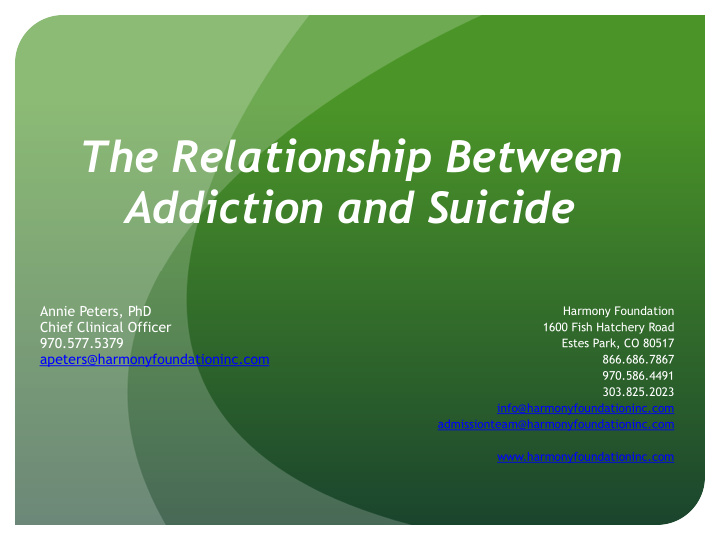



The Relationship Between Addiction and Suicide Annie Peters, PhD Harmony Foundation Chief Clinical Officer 1600 Fish Hatchery Road 970.577.5379 Estes Park, CO 80517 apeters@harmonyfoundationinc.com 866.686.7867 info@harmonyfoundationinc.com 970.586.4491 admissionteam@harmonyfoundationinc.com 303.825.2023 www.harmonyfoundationinc.com
Facts About Suicide ● Every 15 minutes, someone dies by suicide in the US (CDC) ● Every 40 seconds worldwide (WHO) ● “Suicide is a preventable public health problem” – prevention efforts depend upon appropriate identification and screening (Kelly Posner, PhD)
Facts About Suicide ● 10 th leading cause of death in the US ● 2 nd leading cause of death for ages 15-24 ● 4 th leading cause of death for ages 18-65 ● Highest rates are among Whites and Native Americans ● Attempts are 3x higher in women ● Completed suicides are 4x higher in men ● Firearms - most common method (CDC)
Addiction and Suicide ● Next to mood disorders, substance abuse is the 2 nd most significant risk factor for suicide (SAMHSA) ● ¼ to ½ of individuals who die by suicide were intoxicated or high at time of death (SAMHSA) ● People with substance use disorders are 10 times more likely to die by suicide than the general population (14x for those who inject drugs) (SAMHSA) ● About 17% of individuals in inpatient addiction programs have attempted suicide (Bakhshani et al., 2010)
Causes of the Relationship ● Alcohol/drug use and suicidality may have a common risk factor ● People with suicidal ideation and behaviors may use drugs or alcohol to cope ● People with drug and alcohol use problems often develop suicidal thoughts/behaviors
Common Risk Factors ● Genetic - Dopamine and serotonin genes - Genetic components of personality traits common in people with SUDs and suicidal behavior ● Aggression ● Decreased inhibition ● Depression and anxiety ● Environmental - Trauma…
Self-Medication Hypothesis ● People with depression and suicidal thoughts may begin to use alcohol and other drugs to manage/numb negative emotions and painful thoughts. ● The chemical use becomes a primary coping strategy and addiction develops. Much like self-injury and other self-destructive behaviors, alcohol/ drug use may be an unintentional attempt to AVOID or DELAY suicide and cope with life.
Alcohol/Drug Use ! Suicide • Short-term effects of alcohol/drug use: - Decreased inhibition - Increased aggressiveness - Impaired judgment - Depressed mood - Withdrawal • Long-term effects: Brain changes that lead to depression and anxiety • • Disruption to relationships, leading to social isolation • Decreased self-esteem • Grief and loss Trauma • National Council for Behavioral Health, 2013
Clinical Implications ● Prevention ● Screening ● Intervention
Prevention ● Know the risk factors ● For suicide: previous suicide attempts, depression, impulsivity, aggression, trauma, discrimination, bullying, hopelessness, low self-esteem, losses, social withdrawal, family conflict… ● Recognize warning signs for both substance abuse and suicide ● Increase protective factors…
Warning Signs Substance Abuse Suicide ● Smell of alcohol, needle marks ● Talking about death/suicide ● Slurred or rapid speech ● Searching for methods ● Lack of coordination or ● Talking about feeling hopeless unsteady gait ● Talking about feeling like a ● Enlarged or constricted pupils burden to others ● Tremors ● Reckless behavior ● Mood swings ● Sleep disturbance ● Increasingly angry/defiant ● Withdrawal/isolation ● Overly energetic/lethargic ● Rage/extreme mood swings ● Lying/rule breaking ● Missing appointments ● Losing interest in things or ● Short term memory loss losing the ability to experience ● Blackouts pleasure
Screening ● Screening for both suicidal thoughts and substance abuse should be integrated into primary care, behavioral health settings, online environments… anywhere people seek help ● Screening for SUDs: CAGE, MAST/DAST ● Screening for suicidality: ● SAFE-T – involves identifying risk factors, protective factors, a formal inquiry (thoughts/plan/behaviors/intent), and an assessment of risk level (http:// www.integration.samhsa.gov/images/res/SAFE_T .pdf) ● C-SSRS - http://www.cssrs.columbia.edu/
Intervention ● Expand access to treatment ● “No wrong door” ● Treat both suicidality and addiction as primary issues ● Treat them simultaneously ● Integrated treatment teams ● Long-term continuing care ● Evidence-based practices
Evidence-Based Practices ● Motivational Interviewing – to reduce shame around suicidal thoughts/behaviors and substance use ● Twelve Step Facilitation or another approach to encourage integration into a supportive social community ● Cognitive-Behavioral Therapy to address self-destructive patterns of thought and behavior
Thank you!
Recommend
More recommend